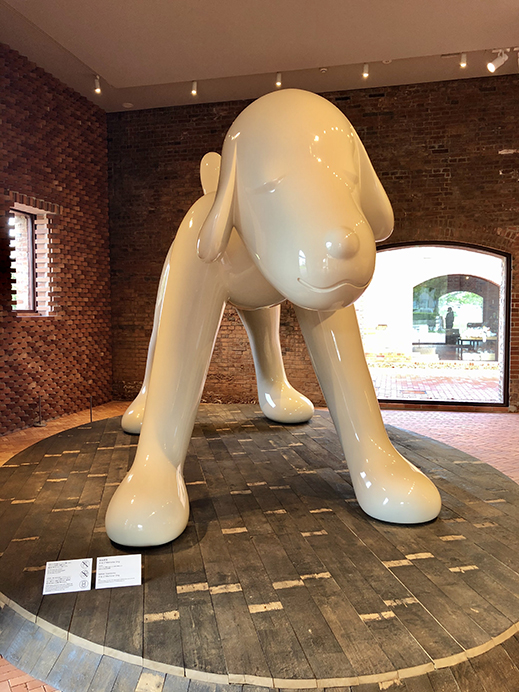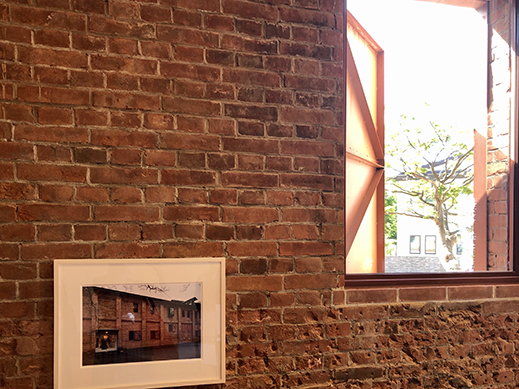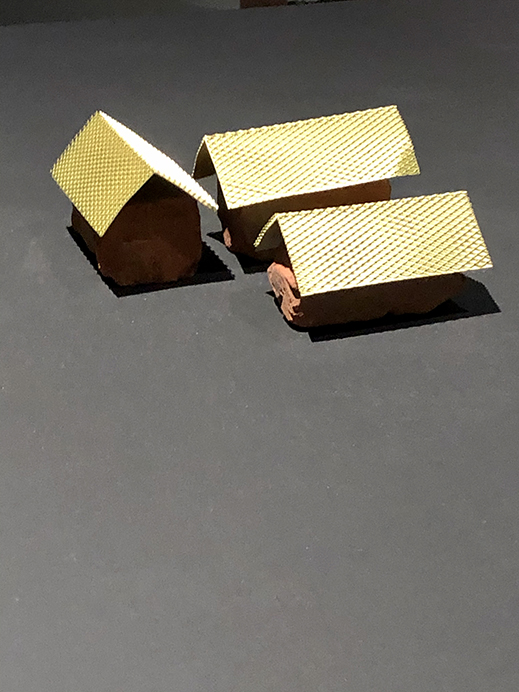 |
Focus features two in-depth reviews each month of fine art, architecture, and design exhibitions at art museums, galleries, and alternative spaces around Japan. |
|
|
 |
 |
 |
A Museum Built of Memories: Hirosaki Museum of Contemporary Art
Jennifer Pastore |
 |
Hirosaki Museum of Contemporary Art, with the original warehouse bricks and a cider-colored titanium roof.
|
Hirosaki Museum of Contemporary Art (Hirosaki MOCA) opened in June 2020, after eight weeks of delay due to the COVID-19 crisis. Architect Tsuyoshi Tane headed the renovation that turned this historic brick warehouse into an art museum. Reflecting its legacy as a former sake and cider brewery and an industrial heritage site integral to the landscape and history of Hirosaki City, the museum titled its inaugural exhibition Thank You Memory: From Cidre to Contemporary Art (ended 22 September). Hirosaki MOCA now continues with a program of exhibitions and events that promote interaction with its architecture, engagement with Hirosaki and the Tohoku region, and the advancement of contemporary art and intercultural exchange.
|
 |
|
|
|
Yoshitomo Nara, A to Z Memorial Dog (2007) at Hirosaki Museum of Contemporary Art, © Yoshitomo Nara. The sculpture commemorates a 2006 Yoshitomo Nara show that led to the site becoming an art museum.
|
What is now the museum started out as a sake factory built on an apple orchard. The current building dates back to 1923, when brewery baron Tosuke Fukushima chose the stately red brick for the structure, as he believed this material would give it longevity. His assumption has proved true throughout the buildingfs multiple reincarnations. In the 1950s, local entrepreneur Isamu Yoshii acquired the site for the mass production of cider, the first such endeavor in Japan. Nikka Whisky later took over the business and used the building as a factory until 1965, when it was converted into storage for government rice stocks after Nikka relocated its factory operations. The creative potential of the building received formal recognition in 2002, when art-world star and Hirosaki native Yoshitomo Nara staged an exhibition there titled I DON'T MIND, IF YOU FORGET ME. Hirosaki City acquired the site and began its transformation into a museum in 2015.
 |
|
Museum interior, with a photograph of the original building.
|
Under the concept "continuation of memories," Tsuyoshi Tane's design for the museum retains the materials, look, and feel of the early-20th century brewery as much as possible. The original brick of the inner and outer walls has been preserved, as has black tar covering the inner walls of the gallery. For the roof, 13,000 panels of striking cider-gold titanium have been installed, giving the building protection from Hirosakifs harsh winters as well as a dazzling patina that adds to the townscape.
Installation view, Thank You Memory: From Cidre to Contemporary Art.
|
|
 |
|
|
|
Concept model of Hirosaki Museum of Contemporary Art, courtesy of Atelier Tsuyoshi Tane Architects.
|
Positing the museum as a "memory device," the inaugural exhibition featured eight contemporary artists who presented mostly site-specific works. These included exhibits documenting the renovation of the building and those produced with the cooperation of locals. Black walls, towering ceilings, and a hushed environment created an ambience of reverence and sophistication. In the first room, materials and artifacts from the site's history such as signs, bottles, and bricks were among the displays. Kazunari Hattori's photo collages combining images from the warehouse's distant past with photographs by Naoya Hatakeyama of the recent renovation blurred the line between documentation and art. A film by Hikaru Fujii projected on the walls of the gallery mixed footage of the building's new and previous iterations, and included interviews with brewery workers and others from various stages of its history.
 |
|
Photo collage by Kazunari Hattori featuring images from the brewery worksite and photography by Naoya Hatakeyama. |
Such documentary-based material might have easily felt plodding or dry, but an infusion of life through art prevented this. Take, for instance, the Thai artist Navin Rawanchaikul's A Letter to Inocchi, an installation that included a letter, a video, and an enormous painted mural weaving together Hirosaki's past and present through key players, among them a prehistoric clay boar discovered in the prefecture. Rawanchaikul sincerely yet playfully addresses Inocchi the boar in the letter and video, recounting what he has learned of Hirosaki's people and places during his research. Inspired by Indian movie billboards and Aomori Prefecture's Neputa festival floats, the 14-meter-wide mural pays homage to Hirosaki heroes who range from historical figures to museum personnel. They all appear together smiling, as if posing for a group photo.
Navin Rawanchaikul, A Letter to Inocchi (partial view) (2020). |
Upstairs on a platform overlooking the first-floor gallery, the Chinese sculptor and installation artist Yin Xiuzhen exhibited her Portable City series of suitcases containing fabric recreations of metropolises around the world. Hirosaki was naturally among them, with the museum and other landmarks constructed out of used clothing donated by local residents. These works allude to how cities are shaped by the stuff of our day-to-day lives and memories.
Yin Xiuzhen, Portable City: Hirosaki (2020).
|
Other featured artists included Yoshitomo Nara and Ishu Han. Nara contributed his ethnologically angled photography from Sakhalin and northern Japan. The 2020 Nissan Art Award-winning Han, who was born in China but, like Nara, spent his formative years in Hirosaki, presented a variety of works including paintings, installations, and videos from throughout his career. The display was an attempt to re-engage with his memories of Hirosaki.
Hirosaki MOCA has more to offer than its galleries. Its community-oriented facilities include a library with books about exhibited artists and their influences. Events open to the public engage with the work of living artists and those central to the regionfs history. The current program takes a look at the avant-garde dramatist Shuji Terayama (1935-83), who also hailed from Hirosaki.
The Hirosaki Museum of Contemporary Art Library. |
Through 21 March 2021, the museum is showing Tsuyoshi Ozawa All Return: "Come back in a hundred years' time. After a hundred years you'll understand." This exhibition spotlights Tsuyoshi Ozawa, an established painter and a creative historian of sorts with a knack for reimaging the past and inserting himself into its narratives. The works on display here continue his series The Return of . . ., which focuses on modern historical figures. Ozawa researches them by traveling to places around the world they visited and creating collaborative works with local artists. For this show, he unveils a new piece centered on a modern-day figure associated with Hirosaki. The work was created with the help of an Iranian painter and musicians. As with the first exhibition, this new show aims to demonstrate the museum's commitment to the past while pointing the way toward the future of art.
 |
|
Tsuyoshi Ozawa, The Return of Painter F (detail) (2015), collection of the Mori Art Museum. Photo by Shizune Shiigi, courtesy of the artist. |
All photos except for the last one by Jennifer Pastore, by permission of Hirosaki Museum of Contemporary Art. |
 |
 |
Jennifer Pastore
Jennifer Pastore is a Tokyo-based art fan and translator. In addition to Artscape Japan, her words have appeared in ArtAsia Pacific, Sotheby's, and other publications. She is an editor at Tokyo Art Beat. |
|
 |
|